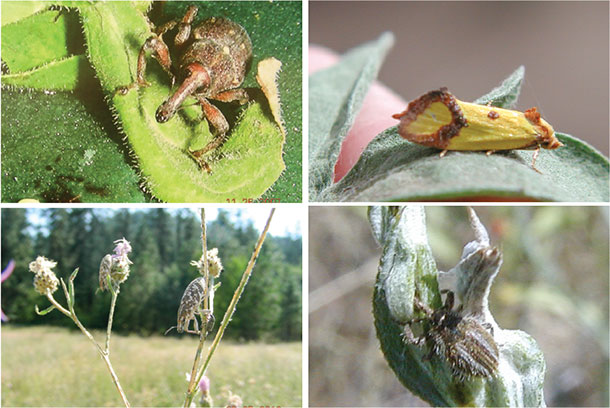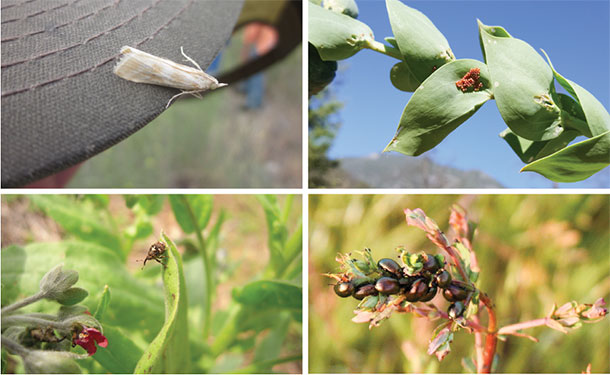Today, there are several strategies for controlling weeds, including use of insects that feed on specific weeds. Paul Brusven, a coordinator for Nez Perce Bio-control Center in Lapwai, Idaho, says biological controls are proving to be successful for a number of weeds.
Over the past 400-plus years of human immigrations into North America, thousands of foreign plant and animal species came along. About one in seven that arrived in the U.S. has become invasive, pushing aside native species.
“An invasive species is defined as a foreign species whose introduction does, or is likely to, cause economic or environmental harm or harm to human health,” Brusven says. “Many of our invasive weed problems originated in Europe and Asia in a climate similar to ours and where they are not weeds; they are part of the natural landscape and evolved through time along with their natural checks and balances.” Some of those checks and balances do not exist on our continent, but in recent years we’ve brought some of them here to combat their host weed.

In the Pacific Northwest, biological control agents have shown success in control of Mediterranean sage, St. John’s wort (klamathweed), tansy ragwort, Dalmatian toadflax and purple loosestrife, and are very helpful in areas where other control methods (herbicides, mowing, hand pulling, replanting competitive vegetation) are impractical. “Biological control agents can also be used in conjunction with other control methods as part of an integrated pest management strategy,” says Brusven.
Jeremey Varley, agriculture section manager for noxious weeds with the Idaho State Department of Agriculture, says the first step is knowing which weed is taking over your pastures, fields or rangelands. “You need to know what you are fighting. If you decide to use biological control, you must be sure you use the right species of insect and that it will work in your situation,” he says.
“For instance, the root weevil for spotted knapweed doesn’t do well in cool, shaded areas. These weevils prefer hot, dry conditions. If you release them next to a stream, or where there are a lot of trees, this is not where they want to be, and they won’t establish very well.”
If you need help determining the best strategy for using biological control, most states have a state biocontrol specialist or a county weed superintendent in your area who can help. “In our state, the ‘Invasive Species of Idaho’ webpage lists the biocontrol agents that are approved to be released,” Varley says. “This is a national list. Several places have biocontrol agents for sale, and some states have programs where you can get assistance purchasing them if it’s an approved agent for a good project.”

Through partnership with a cooperative entity such as the county, you can often get biocontrol agents at no cost. “There are several programs available to assist. Some places that sell these agents charge $1 per bug or more for the knapweed root weevil, for instance, so you might want to participate in a program that helps with this expense.”
Biocontrol research is ongoing. These agents are species-specific and also affected by climate and habitat conditions. “An organization called CABI (Center for Agriculture and Bioscience International) from Switzerland does research on biocontrol agents, looking for species that work on certain weeds. They go to the native land of a plant we consider a noxious weed here and find its native predators. Then they determine the life cycle of the predator agent and make sure it only feeds on that particular plant and can’t complete its life cycle on any other plant,” says Varley. Then we know we can safely release these agents in a noxious weed patch in this country and they won’t damage any other plants.
Various people find funding for research. “A group concerned with rush skeletonweed is looking for a new biocontrol for that one. After they find one, it will be brought here for more testing. It must pass through USDA-APHIS’s Technical Advisory Group (TAG) before it can be approved for release,” he says. Each agent must go through this process to be approved for use in the U.S.
It takes several years and lots of money to bring biocontrol agents to this country. “We follow up to make sure they are working how we want them to. In many cases they do, by reducing seed count or plant vigor in the target weed,” says Varley.
You may not see immediate results after a release; it takes time for a population of insects to become established. It may be three to five years or longer before you see a real difference in weed reduction. “It’s not like herbicide where you spray the weeds and go out the next day and find them dead,” he says.
Monitoring the site with photos can show the reduction over time. “These agents have to get their numbers up, but the ones that meet all our criteria do a good job – if they are in the right place, targeting the right species,” says Varley.
Every region is unique in climate, and there are weeds in some parts of the U.S. that we don’t see in other areas. “There are biocontrol agents available for most of these noxious or invasive weeds. The ones we are using have made a big difference. In Lemhi County [Idaho], we used the root weevil Cyphocleonus achates for spotted knapweed, along with the sulfur moth Agapeta zoegana to attack seedheads and the flower weevils (Larinus minutus and Larinus obtusus) to help control this hardy perennial. With the root feeders and several agents to attack the seedheads, knapweed can be dramatically reduced over time,” he says.
Some times of the year, you can graze invasive plants, especially when they are still young and palatable, and set them back. “With leafy spurge, many people have utilized goat grazing. Biocontrol agents have more effectiveness after grazing. The plants have new growth following grazing, and the new growth is more susceptible to the biocontrol agents,” explains Varley. Often, if you can employ multiple tools, you’ll see better results.
Biocontrol agents may provide a long-term solution because they are the natural enemy of that particular weed. This is how Mother Nature keeps things in balance. ![]()
PHOTO 1 TOP LEFT: Loosestrife root weevil
PHOTO 1 TOP RIGHT: A root weevil on knapweed
PHOTO 1 BOTTOM LEFT: Knapweed root weevil on a knapweed blossom
PHOTO 1 BOTTOM RIGHT: Weevil that feeds on yellow starthistle
PHOTO 2 TOP LEFT: Root moth that attacks rush skeletonweed
PHOTO 2 TOP RIGHT: Eggs of the stem-boring weevil that attacks Dalmation toadflax
PHOTO 2 BOTTOM LEFT: Root weevil on a houndstongue plant
PHOTO 2 BOTTOM RIGHT: St. John’s wort klammathweed beetle. Photos provided by Paul Brusven.
Heather Thomas is a freelance writer based in Idaho.







